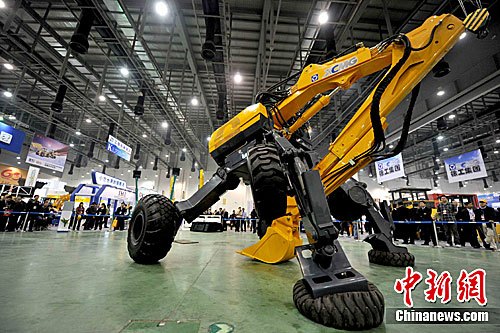The walking type full-scale excavator is an extension and supplement of the crawler excavator function. The crawler excavator has strong power, a wide range of use, and a high market share, and is the most widely used excavator. However, due to the structural limitations of crawler excavators, it is not possible to perform safe and efficient operations on complex terrains such as rough or steep or muddy or tall obstacles, and only rely on manual operations. So there was a "Spider-Man" walking type full-scale excavator.
The walking excavator is a full-scale multi-purpose excavator and multi-tool, multi-functional platform. It is composed of working equipment, getting on and off the vehicle, turning mechanism and hydraulic system. It supports the whole machine with four legs (also can carry the walking wheel). The four legs are operated independently with four hydraulic cylinders. The length of the four legs is The support position can be adjusted in the vertical, horizontal and vertical directions, which greatly improves the applicability and stability of the excavator, and is very suitable for excavating work on uneven and narrow sites.
On the train: Work device (usually box-type telescopic stick excavation arm), cab, 360-degree rotation platform
Chassis: multi-directional joint; steering hydraulic legs; steering device; hydraulic drive motor; tire (or simple track, etc.)
The walking excavator works in much the same way as a conventional crawler excavator, with the main difference being the running part of the chassis. It overcomes the disadvantages of traditional tracked excavators that cannot work in complex terrain, such as in high-angle mountains, high vertical obstacles, rivers, swamps, snow mountains, and railway tracks. The use of independent multi-degree freedom steering steering hydraulic legs allows for free angle adjustment, compensates terrain elevation and elevation differences, achieves the purpose of driving, construction and construction in steep angle terrain; uses box-type telescopic stick to dig arms and independent multi-degree-of-freedom steering hydraulic branch With the help of the legs, it can climb, cross over several meters of vertical obstacles, walk in rivers and swamps, and operate; configure hydraulic steel wire rope hoists to work in large-angle mountains (large geological looseness), and fix the steel wire rope during operation. The supporting claws fix the ground to provide safe working results. It can also be equipped with a hydraulic motor to achieve a short-distance independent transition. The quick-change joints can be installed. Hydraulic perforating devices, hydraulic breakers, grabs, hydraulic shears, pile drivers can be installed. Small digging heads form a multifunctional platform. When the long-distance transfer moves, the excavator does not need any lifting equipment and can climb or climb the transport vehicle on its own. The transfer of the construction site is particularly convenient and the transfer fee is low.
Walking excavators are widely used in military installations, highways, dredging of municipal rivers, trenching of field communication cables, drilling of blast holes in complex terrain, rock breaking, handling of heavy objects, and lifting.

characteristics:
Low elongation in warp and good troughability in weft.
Good water resistance.
Free of mustiness.
Good performance in wet environment.
Suitabl for medium and long distance, heavy-load transportation of materials.
The polyester conveyor belts can choose a relative low safety factor because of the high initial modulus of polyester.
The belts are widely used in mineral, food and industrial.
Wear Resistant Conveyor Belt,Abrasion Resistant Conveyor Belt,EP Conveyor Belt
HEBEI JIUZHOU RUBBER TECHNOLOGY CO.,LTD , http://www.jiuzhoubelting.com